I’ve developed the ultimate meal planning approach focused on how to decide what to eat and how to start cooking for yourself. But I will only be free if I can take you with me into meal planning liberation.
Here’s the thing. I’m pretty good at meal planning. I learned a lot over the course of three years or so as I’ve recovered from my decade-plus-long eating disorder (I went the intuitive eating route, which I loved!). That’s a story for another day, but rest assured – I am never one to skimp on delicious, nutritious, mostly home-cooked meals that support my mental and physical wellness.
I take my health VERY seriously, and nailing my diet has been both a delight and a wonderful privilege. Food brings me so much joy and supports my movement, wellness, and aesthetic goals, when it used to be nothing but a burden and a source of stress. Meal prep as self care has changed my outlook on food, and I want to share my process with you.
In researching for this post, I’ve been scrolling through meal prep guides that prescribe what you should eat and when you should eat it. Some will even try to tell you why. Let’s stop pretending that meal planning is a one-size-fits-all situation. Everyone has different preferences and needs, and it’s crazy to think that I, a random person online, could tell you, a sovereign human being, what you will want to eat next week. The hardest part can often be decision fatigue in trying to predict your tastes. So this meal planning guide is built on a foundation of HOW TO DECIDE WHAT TO EAT.
Free me from the hell of scrolling through these prescriptive, presumptuous posts by reading my guide. If you know any folx who have also wondered, “how do I start cooking for myself?” share it with them!
A little disclaimer: this is a guide for feeding YOU! If you’re responsible for feeding others, you’ll have to adapt the principles to account for other people’s tastes, too. I think it could be done, but I don’t have kids, so YMMV.
The goals of this meal planning guide (or: why you should attempt to decide what to eat ahead of time)
Here’s what I’ve achieved through this method, in order of priority. Think of these as the goals of this operation.
- Always have enough of something I want available to me
- Maximize my grocery budget
- Limit decision fatigue while maintaining variety
- Support my well-being, including movement and strength goals
- Impress everyone who comes into my house by offering them a delicious snack that I whipped up myself
Some considerations as you learn how to decide what to eat and cook for yourself
Why shouldn’t you decide what to eat around specific health goals, calories, or macros?
One: because the vast majority of flavor profiles can be adjusted to meet any specific needs I have, like protein. More on that later. And two: because if I end up unhappy with what I’ve made for the week for one reason or another, I’ll adjust accordingly the following week to get more of what my body wants. Nothing ever has to be perfect, especially not on the first try.
I apply this principle to everything, including desserts and fancy treats. I don’t want ice cream every week. Some weeks, I want ice cream every day. This doesn’t undermine my movement or strength goals because my ultimate objective is a harmonious relationship with my body. I trust that my body needs variation, and it will let me know when it’s done craving ice cream by craving protein-rich smoothies instead. Since I probably won’t want that ice cream next week, this week is an opportunity to meet my body’s desire for novelty or delight. Better take it while I have the chance!
And I’m not going to lie – my body has rewarded me for this pattern tenfold. By hitting strength goals, sustaining my good moods, maintaining stable mental health, having great focus, high quality sleep and stress management during tough times, and yes, by meeting my aesthetic goals. All without any of the obsessive fixation I had during my eating disorder.
All this because I eat whatever I want? Yes. It’s true. This framework has NEVER failed me, and if it sounds appealing to you, I recommend looking into intuitive eating. Researcher Stephanie Buttermore has an amazing video on this topic.
But Zarina, I can’t cook. Why not just plan “easy meals” and call it a day?
I learned how to cook in recovery, during my intuitive eating program, so believe me, I understand how intimidating it can be to learn these new skills. Especially if you’re stressed or have baggage surrounding food! But I don’t plan around difficulty because almost every dish I want has an “easy” version and a “hard” version. As you start to cook for yourself, try focusing on learning how to make what you WANT to eat. The ultimate goal is to build a positive relationship with feeding yourself. Even something you might think of as “unhealthy” can be made differently to support your wellness goals.
You want pizza? Hard mode: make your own crust, grate your own cheese, chop your fresh toppings. Easy mode: Premade crust, bagged shredded cheese, topped with dry basil and oregano from the spice cabinet.
Clam chowder? Hard mode: I am shucking these clams with my own hands (and maybe stabbing my thumb with a butter knife…). Easy mode: canned clam meat and a shorter recipe with a shorter list of ingredients. How to decide what to eat is the hard part, learning how to cook will come second.
Tacos? Hard mode: mix your own taco seasoning. Easy mode: buy the packet.
Let’s also get this straight: there is NO shame in using premade, pre-chopped, or canned ingredients, especially when you’re first starting out with meal prep, and ESPECIALLY if you’re responsible for feeding others. There are also ways to store pre-chopped veggies that will help them stay good as long as their whole counterparts.
I’ve found that how challenging or advanced a recipe is usually comes from the number and preparation of ingredients and the number of steps. This isn’t always the case, but it is for most things I like. (I don’t crave créme brûlée very often.) When searching for recipes, add “easy” or “healthy” or whatever your qualifier may be. If you get comfortable with a recipe, take on a more challenging version of the same thing next time. And even if you find an easy version that involves more prep than you’re up for, get ingredients that are prepped ahead of time to take even more mental load off. Set yourself up for SUCCESS, then fine tune culinary skills as you go.
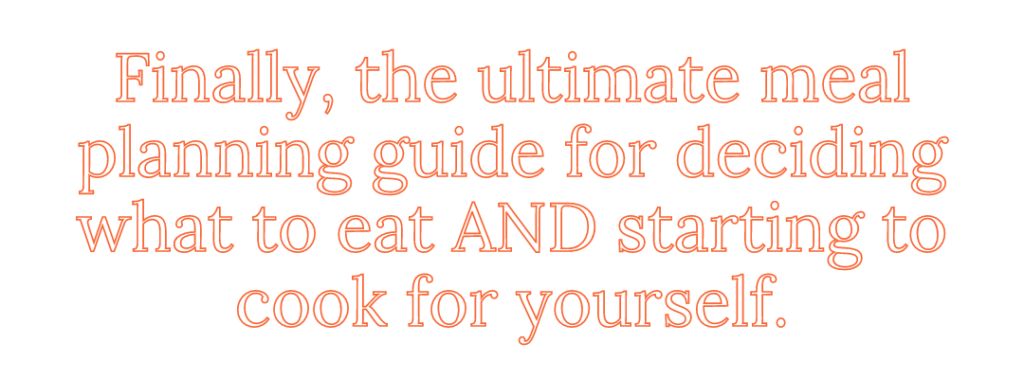
Step 1: how to actually decide what to eat
Right into the hard part. First off, stop overthinking NOW.
Then, list 5 dishes you like. Include restaurant meals, stuff your mom made, and anything you were thinking of leaving out because it’s “embarrassing,” like cake or Spaghettios. If you’re drawing a blank, go through the following questions and think of examples for each one.
- Do I prefer hot or cold food?
- Crunchy or soft food?
- Sweet or savory?
- What was the last thing I ate that I enjoyed?
- What’s a meal that holds a good memory or association for me?
- What’s something I’d be really proud of being able to make?
You’re not trying to figure out what you want to eat now, you’re trying to figure out your historical tastes as a foundation. “How to decide what to eat” is the same as “building the skill of predicting your tastes.” Using your previous favs is just a hack to get there faster. Meal planning may be complex and loaded for some folx, but just know that all the extra anxiety surrounding food choices and prep can be resolved with time, a neutral approach to eating, and a little patience. The principles of meal planning may be helpful to you here.
Here’s my example list of “dishes I like:”
- Pizza
- Mushroom ravioli
- Clam chowder
- Nachos
- Tuna fish sandwich
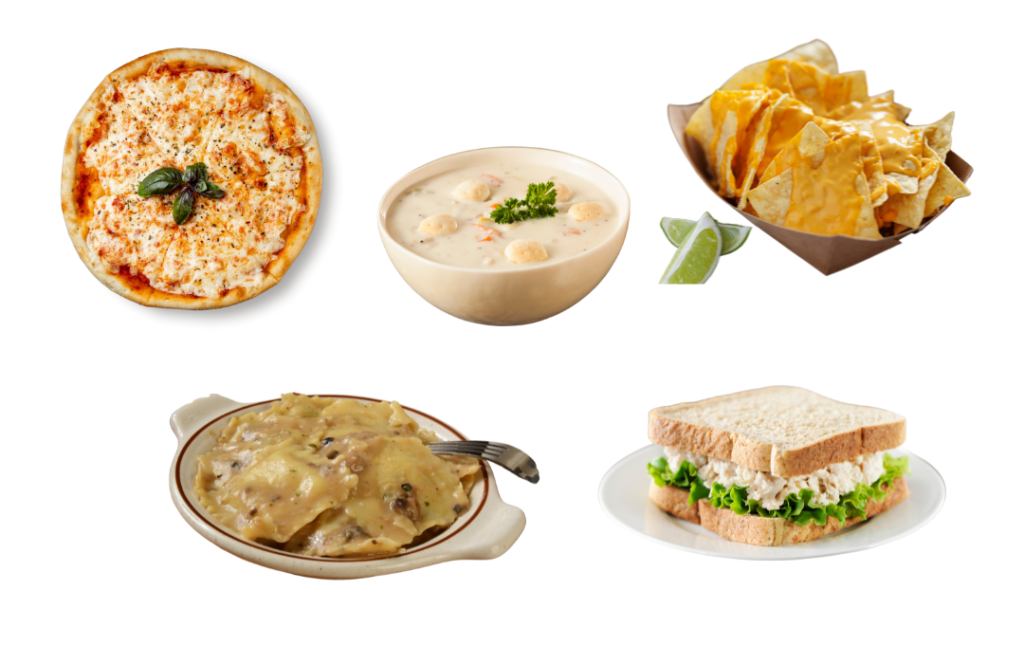
Step 2: identify the ✨ flavor profiles ✨
These are not the actual culinary flavor profiles that chefs talk about. This is BASIC. Examine each dish on your favorites list and zoom out to identify the big components in each dish. So, continuing our example:
- Pizza – tomatoes, cheese and bread
- Mushroom ravioli – umami (mushroom), cheese and pasta
- Clam chowder – fish and cream
- Nachos – cheese and tortilla chips
- Tuna fish sandwich – fish and bread

Oh, whoa, so I like cheese, huh? Great. Cheese is loaded with protein. We’re 60% of the way there.
Notice that “bread” or some kind of carb shows up multiple times on the list. All that tells me is that my body needs carbs every day, and that’s not news to me. Carbs are super, super important for energy and even building muscle (surprised?). They are a major component of every single meal I eat, and I don’t fuck with fad diets like keto because they aren’t sustainable and ultimately present long-term risks. I love a variety of types of carbs (whole grain bread, refined bread products, starchy vegetables, croutons, whatever) and they are present in every meal in some form.
So I’ll go ahead and cross all those carbs off this list and add bread, pizza dough, and tortilla chips to my grocery list.
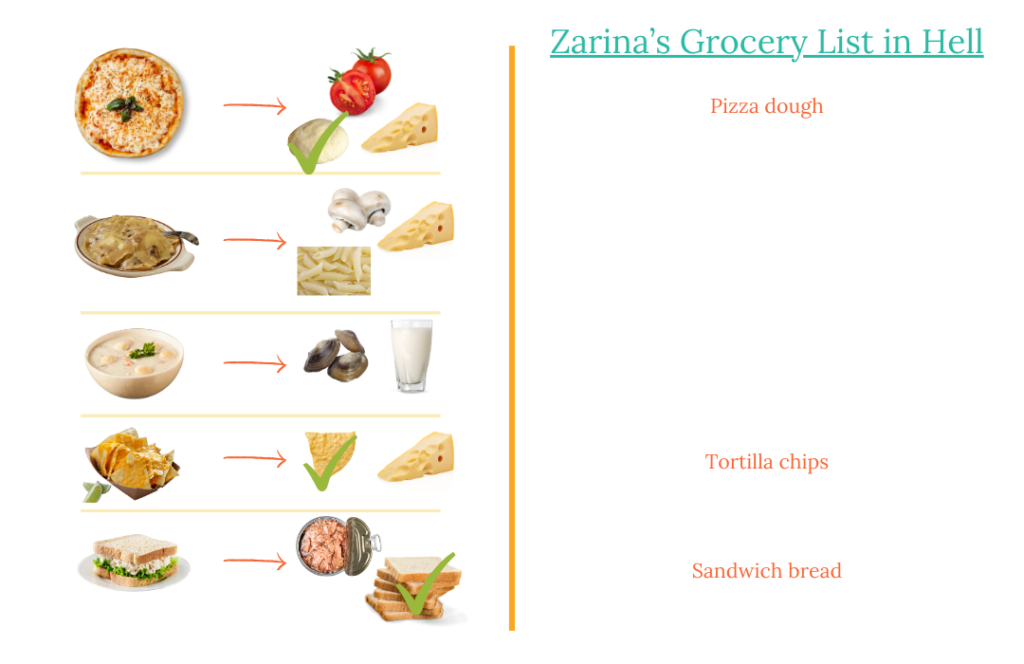
Step 3: meal plan around INGREDIENTS as you decide what to eat (and buy).
Why plan around ingredients, not meals?
Primarily because it’s cheap and EASY. Remember: the goals are to have something I want available, limit decision fatigue, AND maximize my budget by using all of what I buy. So it’s in my best interest to purchase the ingredients that I know I’m going to eat because they go into multiple dishes that I like, rather than buy ingredients that go into random dishes and nothing else in my recipe queue.
Here’s the grocery list after I’ve decided what to eat:
- Marinara sauce – for pizza and for ravioli. (There is NO reason to buy specific pizza sauce. My good friend Kayla taught me this. Also, ignore that the picture I used has cream sauce on there. I like marinara.)
- Cheese – pre-shredded mozzarella/asiago mix for pizza and nachos, plus a chunk of parmesan for ravioli and pizza topping. Always mix cheeses in your homemade pizza!!
- Heavy cream – stays fresh for a while and goes in the chowder
- Canned tuna for the tuna salad
- Canned clam meat for the chowder
- Bagged ravioli (Buitoni, Rana, etc)
- Bread (I like sourdough)
- Tortilla chips
- Pizza dough… or naan. I loooove making pizza on naan (another inspired move Kayla showed me).
- Lemons (for the tuna salad)
- Relish (my fav tuna salad recipe calls for this, plus it lasts forever)
- Celery (for the tuna salad and chowder)
- Better than Bouillon (“broth” for the chowder – this stuff tastes amazing and stays good forever)
- Clam juice (chowder, plan to use all of it since it doesn’t keep)
- Mayonnaise (for the tuna salad, and stays good forever)
- If you’re running low: salt, pepper, and cooking oil.
Here’s a visual to help conceptualize the reusing of ingredients. Note the ingredients that go into multiple dishes.
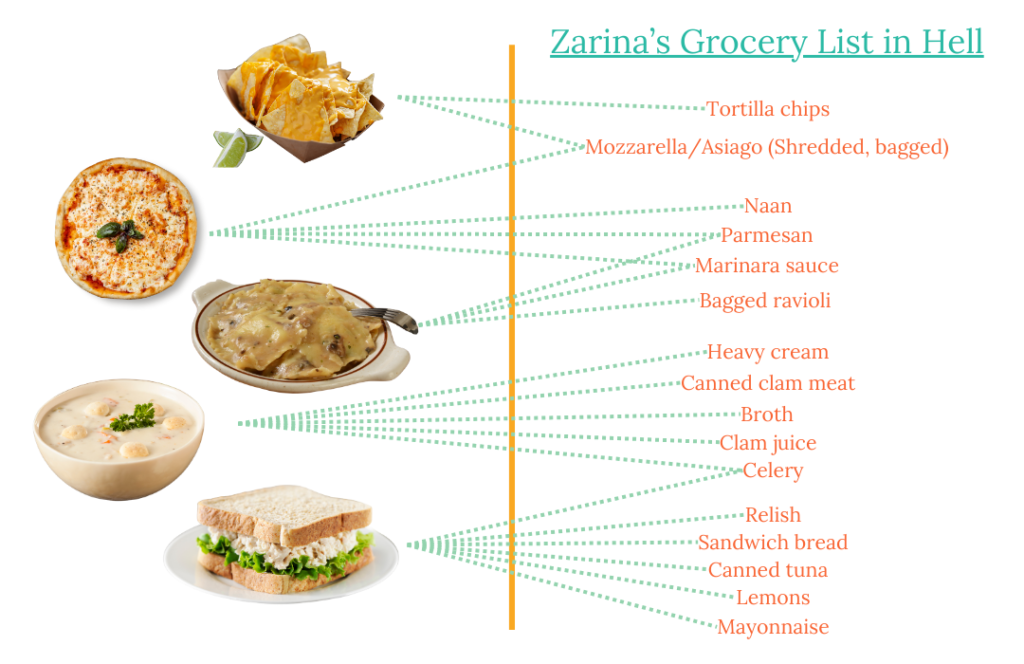
Step 4: decide what to eat the following week based on the previous week.
There are a few ways to approach this. You can use all of them or a combination of them.
Decide what to eat next week to suit your needs and/or goals.
Say you want more protein. Add a chicken parmesan that will use a chunk of the cheese you already bought for the pizza and ravioli. “How to decide what to eat” has to do with tastes, yes, but conscious food choices matter too.
Say you want to spend a little less money. Maybe you opt to make a pasta dish the following week, because pasta is inexpensive and you have marinara sauce already.
Part of nailing this process is accepting that it will take time to understand your preference for fresh or shelf-stable ingredients and finding YOUR personal favorite ways to store and use things in a timely manner. It will also take time to understand what types of flavors and ingredients your body wants, week to week. There is no overnight fix for anything, so bear with the process until you have a sense for what your tastes are like and how your chosen ingredients and profiles are working for you and your body. Remember – failure is a part of EVERY process. It’s only a true failure if you stop trying. I would say “don’t get discouraged,” but the truth is that failure is an opportunity – BE ENCOURAGED by it.
Maximize your grocery budget by using everything you bought the week before.
Lemons come in a bag of 8529234, and one thing about me is that I HATE wasting food. It’s not in my value system to let food to go waste, especially now that I have years of cooking experience. (In the beginning, things did get wasted, but that’s part of the process. No one is perfect out the gate.)
Here’s how I maximize my grocery budget: I try my best to use up the 900 unaccounted-for lemons by squeezing them into mocktails, smoothies, or sauces. I’ll even use gross old ones to shine the sink.
Any vegetable scraps I create during prep go into the freezer, and when I’ve gathered enough, they go into a homemade broth that I make in my slow cooker. The easiest way to stop buying broth or bouillon. I also save chicken scraps in the freezer for broth.
Got leftover tuna salad (which doesn’t stay good for long, btw)? Get a small bag of baby carrots to dip for an afternoon snack. Remaining baby carrots can be tossed into next week’s soup with the leftover celery from the chowder.
Say you want something warm and nourishing for a cold week. Make a creamy sauce for pasta the following week to use up that heavy cream. I’ve even heated up frozen chicken nuggets to throw into a Caesar salad. Search for “pasta sauce that uses heavy cream” or “how to use leftover carrots” for these types of puzzles.
Here’s a fun one: I recently made lasagna and I had 1/3 of a tub of ricotta left over. Instead of tossing it, I’ve been putting it in smoothies to sneak in a little protein and using lemon juice to get the tang that my usual Greek yogurt would have provided. I didn’t buy the Greek yogurt this week because I already had the ricotta.
Maximizing and stretching your grocery budget is a direct result of using what you already have. Since your ingredients were chosen to support your preferred flavor profiles, there’s a higher chance that you’ll be able to continue making food you enjoy in subsequent weeks. You will also reuse more and more ingredients over time. For example, if you decide you like the tuna salad you made for your sandwich, you’ll have mayo left over to make it again. If you decide it was okay but you don’t want to eat it again, make it for guests. Either way, the mayo you bought once will be there for 5+ batches of tuna salad!
Decide what to eat the following week by considering how you felt the previous week.
Didn’t enjoy cooking anything, but particularly hated making the tuna salad? Great, we’re not making that again. Look up ways to use mayonnaise and make whatever looks good and easy online, and don’t buy tuna the following week.
Alternatively, was your workout recovery worse this week? Next week, make something protein-heavy with similar ingredients. I would go for chicken parmesan, because then I can use the parmesan cheese I already bought.
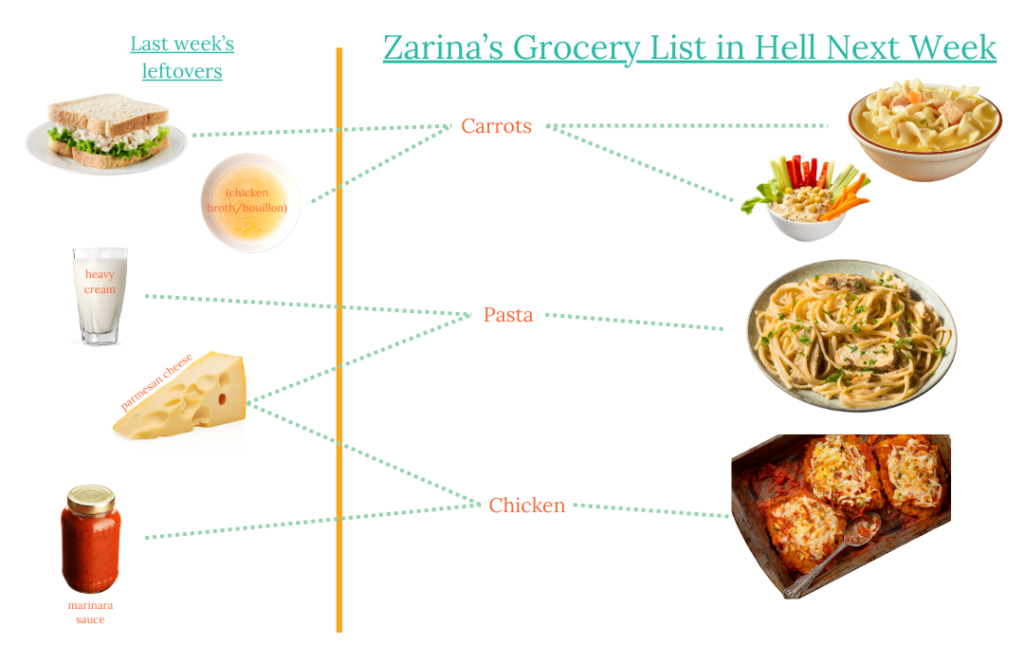
Other things to keep in mind as you start to cook for yourself
Here are some things to keep an eye on as you learn how to decide what to eat and how to start cooking for yourself:
- When to make things over the course of the week. The 5 entrees in this example are not meant to be cooked all in one day! You might be someone who likes cooking for the whole week on one specific day. I prefer staggering recipes throughout the week because I don’t want to shop as frequently, plus it takes me 4-5 days to finish most of my entrees. Realistically, 5 entrees would last me, a single person only feeding myself, 2+ weeks. This will depend on how much and how often you eat.
- Meal-appropriateness. I am not having clam chowder for breakfast, I swear. I eat three solid meals a day, but that usually means pouring a big bowl of cereal and making a smoothie for breakfast and focusing on cooking for lunch and dinner. Maybe you prefer to prep and cook your breakfast.
- Meal completeness. Let’s say your soup for the week is a little light and leaves you hungry after 2 hours. This can be resolved through a side dish. Dress up the soup into a full meal by adding a slice of your sandwich bread and some fresh grated parmesan. Consider grabbing some Greek yogurt or skyr to have as a protein-rich side to any dish, or some of those frozen biscuits that come in a little metal can to fill out a meal.
- Prioritizing recipes that use perishable ingredients. If these were the entrees I had chosen for the week (realistically, 5 entrees is more like 2 weeks, like I said), I would make the tuna salad and clam chowder ASAP, then make personal naan pizzas whenever I want something different.
- Fallback recipes and ingredients as fail-safes. I keep low- or no-prep options on hand so that I don’t have to think about deciding what to eat every day. Instead, I can choose from my prepared meals, or I can have the frozen chicken nuggets that are always in my freezer.
- Fine-tuning quality and quantity. Maybe you find that you use up all your marinara sauce this week. You may wish to buy it in bulk or purchase a cheaper option if it’s something you use a lot. Alternatively, you may wish to start making your own marinara sauce to attune it to your tastes, or to save money. There are many options for fine-tuning the quantity and quality to suit your needs.
- Ongoing research. If you find yourself puzzling over something in the kitchen, I cannot stress the impact of just looking it up. You don’t have to know everything. My search history is full of queries like “how long can I freeze kale?” and “how to use leftover taco meat.” I’ll even look up stuff like “what seasonings go well with chicken” and “how to reheat alfredo so it doesn’t get greasy.” The answers are truly at your sauce-sticky fingertips.
There you have it, the definitive guide on how to decide what to eat and how to start cooking for yourself. Got questions? Leave them in the comments below! Happy meal prepping. 💙
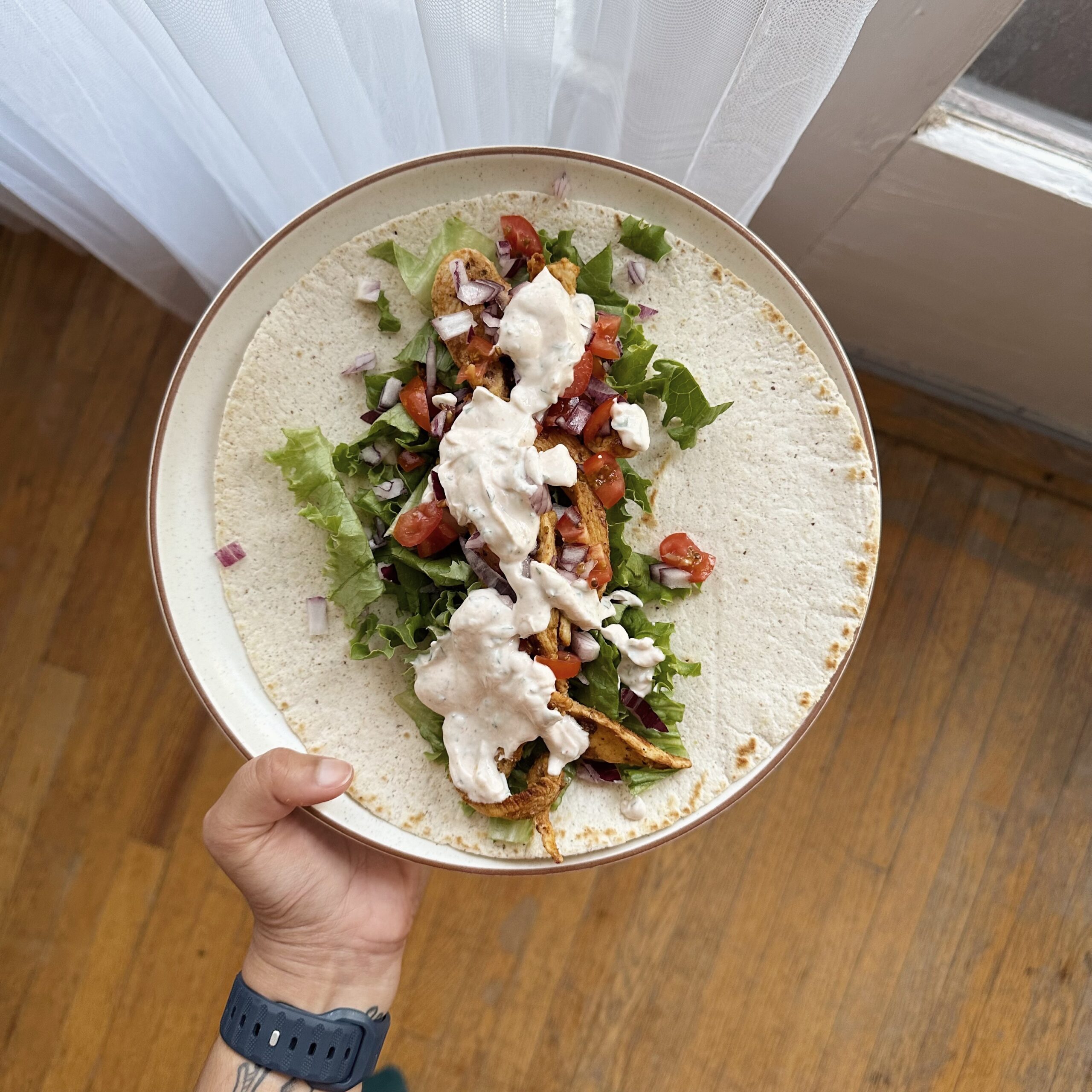
Comments
One response to “Read this meal planning guide to free me from hell”
[…] leftovers: Leftovers can be transformed into entirely new dishes. For example, the tuna salad in my meal planning post from last week can be used in sandwiches, but also as a dip! Roasted some veggies for dinner? Throw them in a […]